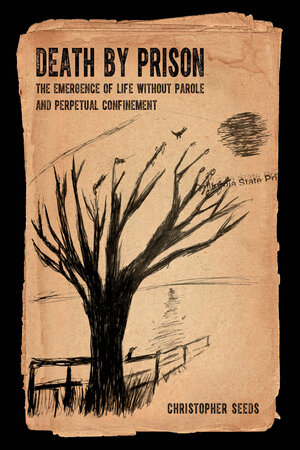
Death by Prison is an ambitious overview of the rise of life sentences for American prisoners. In the interview below, author Christopher Seeds explains some of the key insights from the book.
Christopher Seeds is Assistant Professor of Criminology, Law and Society at the University of California, Irvine.
In recent decades, life imprisonment without the possibility of parole (LWOP) has developed into a distinctive penal form in the United States, one firmly entrenched in US policy-making, judicial and prosecutorial decision-making, correctional practice, and public discourse. LWOP is now a routine part of contemporary US criminal justice, even engrained in the nation’s cultural imaginary, but how it came to be so remains in question. Fifty years ago, imprisoning a person until death was an extraordinary sentence; today, it accounts for an increasing percentage of all US prisoners. What explains the shifts in penal practice and the social imagination by which we have become accustomed to imprisoning individuals until death without any reevaluation or reasonable expectation of release? Combining a wide historical lens with detailed state- and institutional-level research, Death by Prison offers a provocative new foundation for questioning this deeply problematic practice that has escaped close scrutiny for too long.
How did you become interested in this topic?
It began with my prior career as a capital defense attorney. For more than a decade, I worked in appellate and post-conviction practice defending people sentenced to death. Our focus all day everyday was on the intricate facts of specific cases and the nuances of legal precedent. I was part of the legal team that litigated the case in which New York invalidated the death penalty, and consequently our office closed.
Not practicing defense work full-time gave me space to reflect on aspects of the legal system from a broader perspective, and to see that there is more at stake than the death penalty. I became concerned with the growth of the US penal system overall, including life sentencing. The Graham v. Florida case, which was decided by the US Supreme Court in 2010 and which I discuss in chapter 3 of the book, was eye-opening. How could a prison sentence lasting a lifetime be such a widely accepted practice—even for youth convicted of a nonhomicide crime? This was something that I felt needed explaining—something I needed to understand.
How does your book contribute to larger discussions of justice reform?
A wave of criminal justice reform followed the great recession of 2007-2009 in the United States. That period, which I would say lasted until roughly 2017, was characterized by bipartisan interest in reducing spending on crime and punishment and downsizing prisons—a response to the excesses of the policies that produced mass incarceration. Yet the reforms were directed principally at changing how states dealt with low-level crimes and gave little attention to reducing prison sentences for people convicted of serious and violent crimes. In fact, certain initiatives invoked severe hard end punishments, such as life without parole, as a foil to broker support for the low-level reforms.
My book, Death by Prison, helps make sense of that bifurcation. I demonstrate a distinct phenomenon that evolved alongside and was obscured by mass incarceration: death in prison sentencing, which involves a specific lack of concern for the indignity of dying in confinement. My goal for the book is to increase awareness—among scholars, policymakers, and the public—of the extent to which the United States uses death in prison sentencing, to recognize this as a distinct phenomenon, and to promote an accurate understanding of the historical circumstances and social processes behind this trend. I hope that by bringing the phenomenon into the light, the book serves as a call to do something about it.
What was something unexpected that you learned over the course of your research?
One unexpected discovery came relatively early in the research. As I delved into historical scholarship on punishment, I found fewer discussions of life sentencing than I expected (far fewer than one finds on the death penalty, for example). And in historical discussions of life sentencing and evidence concerning past practices, I observed that “life imprisonment without parole” was not necessarily a death in prison sentence as we understand it today. Clemency was once a more regular practice and used quite actively for deciding release for lifers in many jurisdictions. Life without parole, or LWOP, was not widely understood to mean no release from prison until the late twentieth century.
Another finding that may be unexpected for readers is that LWOP’s value as an alternative to capital punishment is but one factor that drove its transformation in the late twentieth century—and it was not always the primary factor. For example, the book discusses how invalidation of the death penalty by the US Supreme Court in 1972 (Furman v. Georgia) did not provoke many states to turn immediately to life without parole, as is often suspected. Rather, Furman had more slowly developing and broad ranging effects: it led to structural changes in penal laws and invigorated conversations about minimum sentences and truth in sentencing, which were foundations on which LWOP later grew.
What is the main message you hope readers take away from the book?
The practice and scale of life without parole sentencing in the contemporary United States—with the certainty of dying in prison—is historically unusual. I would call it an aberration. It is a phenomenon of the past half century. Life without parole is not a sanction so institutionalized elsewhere in the world; it is not a punishment that, historically in the United States, necessarily meant death in prison.
Recognizing this helps one acknowledge that the practice can be changed—with care and attention. One of the principal themes drawn out in the book is that disregard is as significant to the growth of death by prison as punitiveness. Changing the nation’s proclivity for perpetual confinement demands vigilance to penal laws and practices and much more attention to the thousands of incarcerated people facing life without parole and other forms of perpetual prison sentences.
